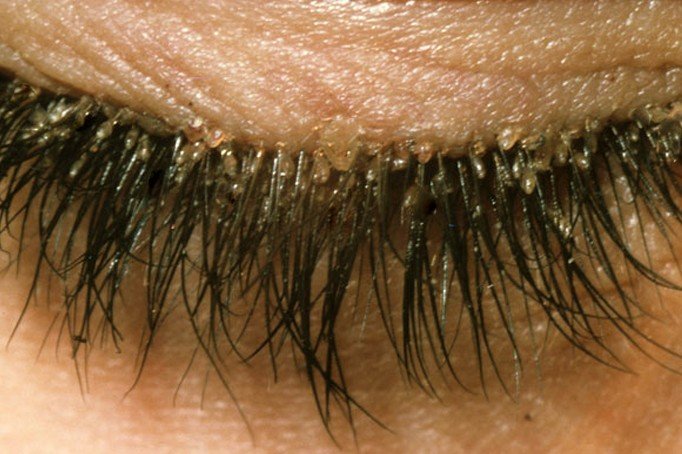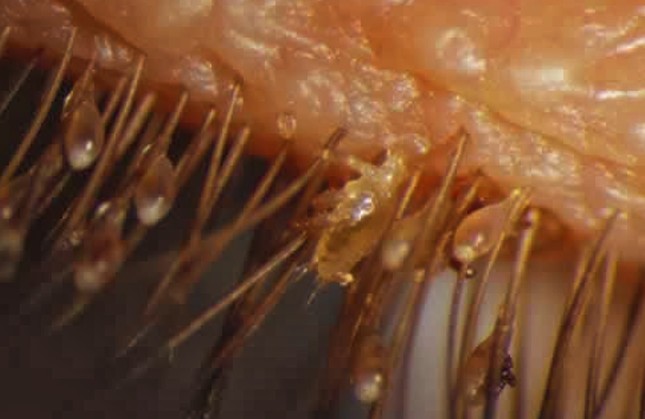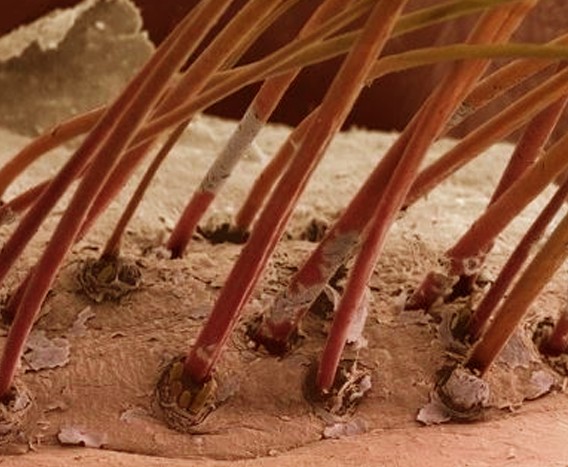What are Eyelash Mites?
The eyelash mites are small parasites belonging to the Demodex family, being found – as the name clearly points out – at the level of the eyelashes. In humans, two species of eyelash mites have been identified, meaning Demodex folliculorum (identified in 1842) and Demodex brevis (identified in 1963). While the first is generally found at the level of the hair follicles, the other one is known to live in the sebaceous glands. Apart from the eyelashes, these mites can be found at the level of the eyebrows and around the nose. It is possible that they are presented in other parts of the body as well.

Eyelash Mites Picture – How do you get eyelash mites?
It is known that the eyelash mites feed themselves with dead skin cells, as well as with the sebum produced at the level of the face. The eyelash mites are transmitted from one person to the other through direct contact (hair, eyebrows or sebaceous glands at the level of the face). The spreading of the eyelash mites is also guaranteed by the dust that contains eggs from these parasites.
The elderly present an increased risk for eyelash mites, while children rarely present such problems (reduced sebum production). It is estimated that, by the age of 60, over 80% of the people present eyelash mites.
According to the latest studies performed in the field, eyelash mites have been recognized as one of the main causes that lead to the chronic inflammation of the eyelids. The brevis mite is known to live inside the sebaceous glands of the eyelashes and also in the meibomian glands. An association has been made between the brevis mite and the meibomian gland disease (associated with the subsequent tear lipid deficiency). On the other hand, the folliculorum mite is more specifically located at the level of the eyelash roots, being more often found in association with the anterior blepharitis.
Life cycle and survival
In general, the life cycle of the eyelash mites varies between two and three weeks. During that period, the female mite will lay eggs inside the hair follicle, at a close distance from the sebaceous glands. From the eggs, the larvae are going to appear, transforming themselves into full-grown mites. The male mite will leave the hair follicle in search of a female. On the other hand, the female mites remain at the level of the respective hair follicle.
Both types of eyelash mites consume epithelial cell cytoplasm, penetrating the cell membrane with ease. The infestation with the folliculorum mite leads to the hyperplasia of the follicles, with an increased keratinization process at the base of the eyelashes. The mixture between the keratinization and lipids leads to the appearance of a characteristic, cylindrical dandruff (associated with blepharitis). It is believed that the dandruff is actually the result of the mite scraping around the follicle.
Symptoms
In the majority of the cases, the eyelash mites do not cause any obvious symptoms. However, in the situation that a person has a suppressed immune system – brought upon by stress or illness – it is possible that the eyelash mites increase as population. The overgrowth of eyelash mites leads to a condition that is known as demodicosis. Among the symptoms of the Demodex mite bite, there are itchiness and swelling. Some patients might also suffer from blepharitis, due to the presence of eyelash mites. Recent studies have correlated the symptoms of acne vulgaris or rosacea with the infection with eyelash mites.
In the situation that the infestation with the Demodex mite is prolonged, the patient might discover that his/her eyelashes have become brittle. Because of the infestation, the eyelashes are easily epilated. If they are present at the level of the eyebrows as well, they can cause itchiness and a burning sensation in the respective area. Such symptoms are more obvious in the morning. Other symptoms include: madarosis (eyelash loss) and sensation of foreign body.
Causes

Picture showing the mites on eyelashes
These are the most common causes that lead to the appearance of eyelash mites:
- Inadequate hygiene
- Low-quality or expired makeup (eye makeup, mascara)
- Infestation from another person
- Air (dust) contamination.
Diagnosis
The identification of the eyelash mites is made by placing an eyelash or an eyebrow hair under a microscope. They may also be identified by scraping the skin on the forehead, gathering the oily secretions produced by the sebaceous glands on a microscope plate.
The slit lamp evaluation is often performed for the identification of Demodex blepharitis (cylindrical dandruff identified). The presence of cylindrical dandruff is suggestive for the infection with the folliculorum mite. The more eyelashes present cylindrical tubules, the more extensive the infection actually has become.
Treatment
There are a number of treatment goals that have to be reached, when it comes to the infestation with eyelash mites. First of all, both the adult and the larvae have to be eliminated. Then, the further mating of the eyelash mites has to be prevented. Re-infestation has to be avoided and the patient’s symptoms to be alleviated.

Eyelash mites on Hair follicles
These are the most common treatments recommended for eyelash mites:
In-office lid scrub/debridement
- Intervention made with local anesthesia
- The eyelashes and the eyebrows are debrided with the help of a cotton tip applicator (previously soaked in tea tree oil)
After the debridement, application of ointment with antibiotics or corticosteroids
- Prevent the moving of the eyelash mites (leading to their suffocation)
- Corticosteroids – relief from the inflammation, associated with the debridement and the decaying mites
- The treatment has to be repeated after a period of 2 weeks.
At home, the patient should follow these instructions:
- Wash sheets and pillow cases with hot water (+dry at high temperature)
- Discard of the pillows
- Makeup cannot be used for 1 week
- Old makeup should be discarded as well
- Tea tree soap and tea tree hair shampoo – recommended choices
- Spouse evaluation required (possible infestation)
- Lip scrub pads – used for the scrubbing of the eyelash margins and the eyebrows (rinsing is not required)
- Application of antibiotic/steroid ointment (only for one week, then replaced with bland ophthalmic ointment – this should be used for three-four weeks)
- Lid scrubs should be performed at least two times per week
- Follow-up required every six months.
Natural remedies
One of the most effective natural remedies against the infection with eyelash mites is represented by the tea tree oil. It is important that this remedy is applied only under the professional guidance of an ophthalmologist. Also, the tea tree oil has to be diluted to 50% concentration (diluted in macadamia or walnut oil). When applying it, make sure that you stick just to the margins of the eye. Avoid getting it into the eye, as it is quite irritating and it will cause a lot of discomfort.
Prevention
Maintaining an excellent hygiene is the best way to prevent the infestation with eyelash mites. Washing the face before going to bed is essential and so is keeping the sheets and the pillow cases clean. Avoid using low-quality or expired makeup, as this can be an obvious source of infection. Also, if you have pets, be sure to check them too, as they can suffer from such infestation as well. Once you take all the necessary measures, you will rest comfortably at night, knowing that are protected against eyelash mites.




